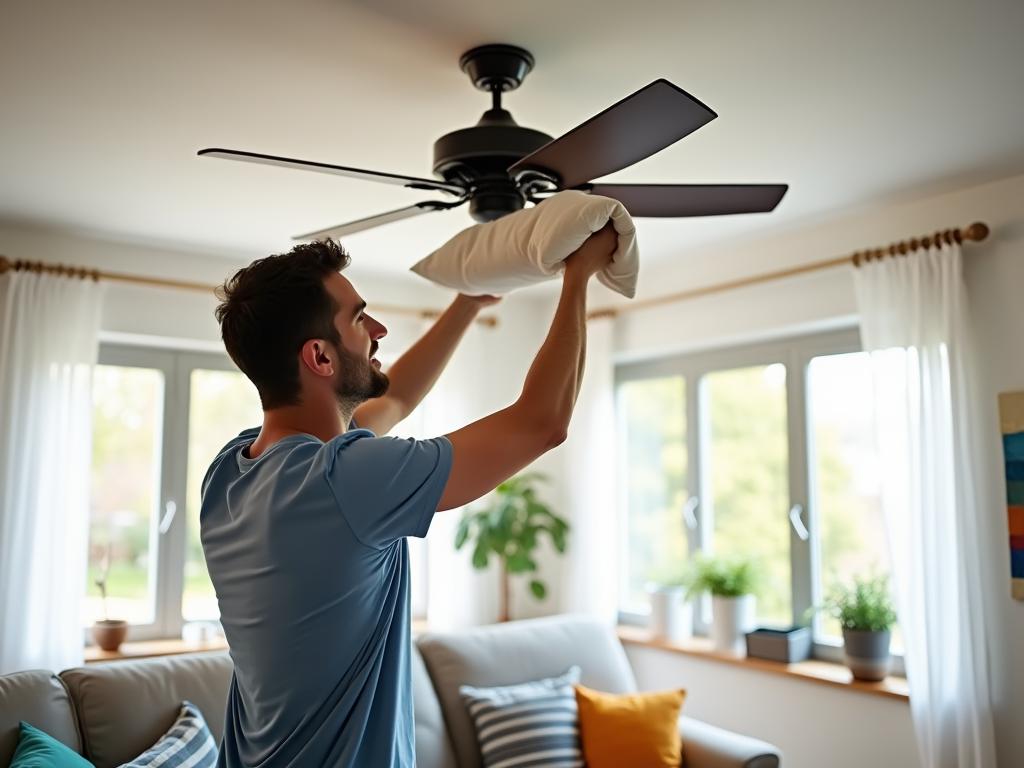Ceiling fans are great for circulating air and keeping a room cool; however, cleaning them can often seem like a daunting task due to the dust that accumulates on the blades. Fortunately, there are effective techniques to clean ceiling fans without getting dust everywhere. This article delves into practical and efficient methods to tackle this chore, ensuring a clean and dust-free home environment.
Preparation: Gathering the Right Tools

Before you begin cleaning, ensure you have all the necessary tools ready, which will help you avoid making a mess. Gather materials such as a step ladder, a ceiling fan cleaning brush, a vacuum with a hose attachment, and an old pillowcase or microfiber cloth. Each of these tools plays a crucial role in the cleaning process. Having a stable step ladder is essential for reaching the fan safely, while the pillowcase or microfiber cloth will capture dust effectively. The vacuum’s hose attachment is perfect for cleaning up any remaining dust particles. Organizing your tools beforehand can save you time and reduce the spread of dust.
Turning Off the Fan

Always turn off your ceiling fan before cleaning to ensure your safety. Cleaning the fan while it’s on can be dangerous and ineffective. You’ll have a better chance of removing dust without it spreading if the blades are static. Furthermore, ensure the fan has come to a complete stop before climbing up to clean it. Not only does this minimize the risk of injury, but it also enhances your ability to clean each blade thoroughly. It can be helpful to unplug the fan or switch off the power at the circuit breaker if possible for added safety.
Use of a Pillowcase Technique
One popular way to clean ceiling fans without dispersing dust is the pillowcase method. This simple trick involves using an old pillowcase to encase the fan blades while capturing the dust. Here’s how to do it:
- Place a step ladder under the fan and ensure it’s stable.
- Slip each blade into the pillowcase, enveloping it completely.
- Gently press the material against the blade and pull it back, trapping the dust inside the pillowcase.
- Repeat the process for each blade until all are clean.
This technique is highly effective in preventing dust from falling onto the floor or furniture. The pillowcase acts as a dust trap, making disposal easy and mess-free. Finish by vacuuming the fan’s motor housing and surrounding areas with your vacuum’s hose attachment to catch any residual dust or debris.
Applying Gentle Cleaning Solutions
Once the dust is removed, you might notice grime or stains on the fan blades. To address this, use a gentle cleaning solution. Mix warm water with a few drops of mild dish soap to create your cleaning agent. Dip a microfiber cloth into the solution, wring it out, and wipe each blade carefully. It’s important not to use too much liquid as it can drip inside the fan and damage the motor. For stubborn stains, consider using a mixture of vinegar and water. This natural solution cuts through grime efficiently and is safe for most surfaces. Always dry the blades thoroughly with a dry cloth after cleaning to prevent watermarks.
Regular Maintenance Tips
Consistency in cleaning will help reduce the amount of dust build-up, making ceiling fan maintenance easier over time. Here are a few tips for keeping your fans clean:
- Clean your ceiling fan at least once a month, especially if used frequently.
- Dust the blades weekly with an extendable duster if the fan is in a high-traffic area.
- Check the motor and other components for dust accumulation regularly.
- Consider investing in a fan blade cover to protect the blades from dust and debris.
By following these maintenance strategies, you can extend the life of your ceiling fan and keep your home environment healthier and dust-free. Regular upkeep not only improves the fan’s efficiency but also contributes to cleaner indoor air, reducing allergies related to dust particles.
Conclusion
Cleaning ceiling fans without spreading dust is achievable with the right tools and methods. From using a pillowcase to trap dust to applying gentle cleaning solutions for stubborn stains, these steps ensure a thorough clean while maintaining home hygiene. Regular maintenance can significantly reduce future dust accumulation, making the cleaning process more manageable. By integrating these practices, you can enjoy a cleaner, dust-free living space and a well-functioning ceiling fan all year round.
Frequently Asked Questions
1. How often should I clean my ceiling fan?
It’s best to clean your ceiling fan at least once a month. However, if the fan is located in a high-traffic area, consider dusting it weekly to prevent excessive dust build-up.
2. Can I use any pillowcase for cleaning my fan?
Yes, using an old or unused pillowcase for cleaning your ceiling fan is advisable. It helps in capturing dust effectively, making it easy to dispose of afterward without creating a mess.
3. Is it safe to use chemical cleaners on fan blades?
It’s generally safer to use mild dish soap mixed with water or a vinegar solution. Harsh chemicals can damage the finish on the blades or harm the fan’s motor if not used carefully.
4. What should I do if my fan blades are non-removable?
For non-removable blades, use the pillowcase method or an extendable duster to clean them effectively. Always ensure the fan is off and the blades are stationary before cleaning.
5. Can I prevent dust from accumulating on my ceiling fan?
While you can’t completely prevent dust accumulation, regular cleaning and maintenance significantly reduce it. Using fan blade covers can also help keep dust at bay in between thorough cleanings.
